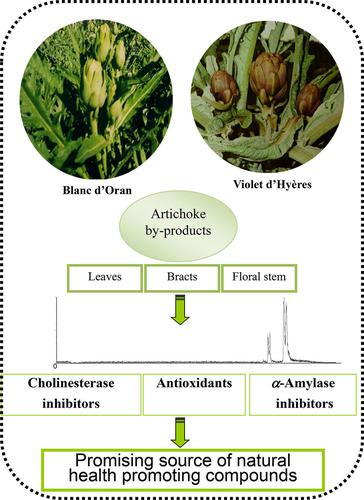当前位置:
X-MOL 学术
›
Chem. Biodivers.
›
论文详情
Our official English website, www.x-mol.net, welcomes your
feedback! (Note: you will need to create a separate account there.)
Chemical composition, antioxidant potential and enzymes inhibitory properties of Globe artichoke by-products
Chemistry & Biodiversity ( IF 2.3 ) Pub Date : 2020-08-21 , DOI: 10.1002/cbdv.202000073 Ines Ben Rejeb 1 , Nahla Dhen 1 , Mohamed Gargouri 1 , Abdennacer Boulila 2
Chemistry & Biodiversity ( IF 2.3 ) Pub Date : 2020-08-21 , DOI: 10.1002/cbdv.202000073 Ines Ben Rejeb 1 , Nahla Dhen 1 , Mohamed Gargouri 1 , Abdennacer Boulila 2
Affiliation

|
In this study, chemical composition and in vitro biological activities of artichoke by‐products (leaves, floral stems and bracts) issued from two Tunisian varieties were evaluated. Analysis was performed by means of high‐performance liquid chromatography with diode array detection coupled to electrospray ionization mass spectrometric (LC/DAD/ESI‐MS). Total phenolic (TPC) and flavonoid (TFC) contents as well as the antioxidant activity conducted by three complementary methods, DPPH, ABTS and FRAP tests, were performed for each sample. Enzyme inhibitory effects against acetylcholinesterase, butyrylcholinesterase and α‐amylase were also studied. Results showed that TPC and TFC varied according to variety as well as the plant part. Bracts presented the highest TPC values (10–15 mg GAE/g DW), while leaves were distinguished by the highest TFC values (52–58 mg EQ/g DW). In vitro assays showed that Violet d'Hyères bracts and Blanc d'Oran leaves present the most antioxidant activities (30.040 and 20.428 mgET/gDW, respectively, by the DPPH method). Leaves demonstrated the highest acetylcholinesterase and butyrylcholinesterase inhibitory effects. Moreover, all organs displayed a noticeable inhibition towards α‐amylase. LC/DAD/MS analysis revealed that artichoke by‐products are a potential source of biopharmaceuticals such as luteolin derivatives from leaves and mono/dicaffeoylquinic acids in the other parts. This research demonstrates that globe artichoke by‐products, unexploited in our country, are a promising source of natural health promoting compounds with potential applications in the food and pharmaceutical industries.
中文翻译:

朝鲜蓟副产品的化学成分、抗氧化潜力和酶抑制特性
在这项研究中,评估了来自两个突尼斯品种的朝鲜蓟副产品(叶、花茎和苞片)的化学成分和体外生物活性。通过高效液相色谱与二极管阵列检测耦合电喷雾电离质谱 (LC/DAD/ESI-MS) 进行分析。对每个样品进行了总酚 (TPC) 和类黄酮 (TFC) 含量以及通过三种互补方法 DPPH、ABTS 和 FRAP 测试进行的抗氧化活性。还研究了对乙酰胆碱酯酶、丁酰胆碱酯酶和α-淀粉酶的酶抑制作用。结果表明,TPC 和 TFC 因品种和植物部位而异。苞片的 TPC 值最高(10-15 mg GAE/g DW),而叶子的特征在于最高的 TFC 值(52-58 mg EQ/g DW)。体外试验表明,紫罗兰叶和白兰地叶具有最高的抗氧化活性(DPPH 方法分别为 30.040 和 20.428 mgET/gDW)。叶表现出最高的乙酰胆碱酯酶和丁酰胆碱酯酶抑制作用。此外,所有器官都对α-淀粉酶表现出明显的抑制作用。LC/DAD/MS 分析表明,朝鲜蓟副产品是生物药物的潜在来源,例如来自叶子的木犀草素衍生物和其他部分的单/二咖啡酰奎宁酸。这项研究表明,在我国未开发的洋蓟副产品是天然健康促进化合物的有前途的来源,在食品和制药行业具有潜在应用。
更新日期:2020-08-21
中文翻译:

朝鲜蓟副产品的化学成分、抗氧化潜力和酶抑制特性
在这项研究中,评估了来自两个突尼斯品种的朝鲜蓟副产品(叶、花茎和苞片)的化学成分和体外生物活性。通过高效液相色谱与二极管阵列检测耦合电喷雾电离质谱 (LC/DAD/ESI-MS) 进行分析。对每个样品进行了总酚 (TPC) 和类黄酮 (TFC) 含量以及通过三种互补方法 DPPH、ABTS 和 FRAP 测试进行的抗氧化活性。还研究了对乙酰胆碱酯酶、丁酰胆碱酯酶和α-淀粉酶的酶抑制作用。结果表明,TPC 和 TFC 因品种和植物部位而异。苞片的 TPC 值最高(10-15 mg GAE/g DW),而叶子的特征在于最高的 TFC 值(52-58 mg EQ/g DW)。体外试验表明,紫罗兰叶和白兰地叶具有最高的抗氧化活性(DPPH 方法分别为 30.040 和 20.428 mgET/gDW)。叶表现出最高的乙酰胆碱酯酶和丁酰胆碱酯酶抑制作用。此外,所有器官都对α-淀粉酶表现出明显的抑制作用。LC/DAD/MS 分析表明,朝鲜蓟副产品是生物药物的潜在来源,例如来自叶子的木犀草素衍生物和其他部分的单/二咖啡酰奎宁酸。这项研究表明,在我国未开发的洋蓟副产品是天然健康促进化合物的有前途的来源,在食品和制药行业具有潜在应用。











































 京公网安备 11010802027423号
京公网安备 11010802027423号